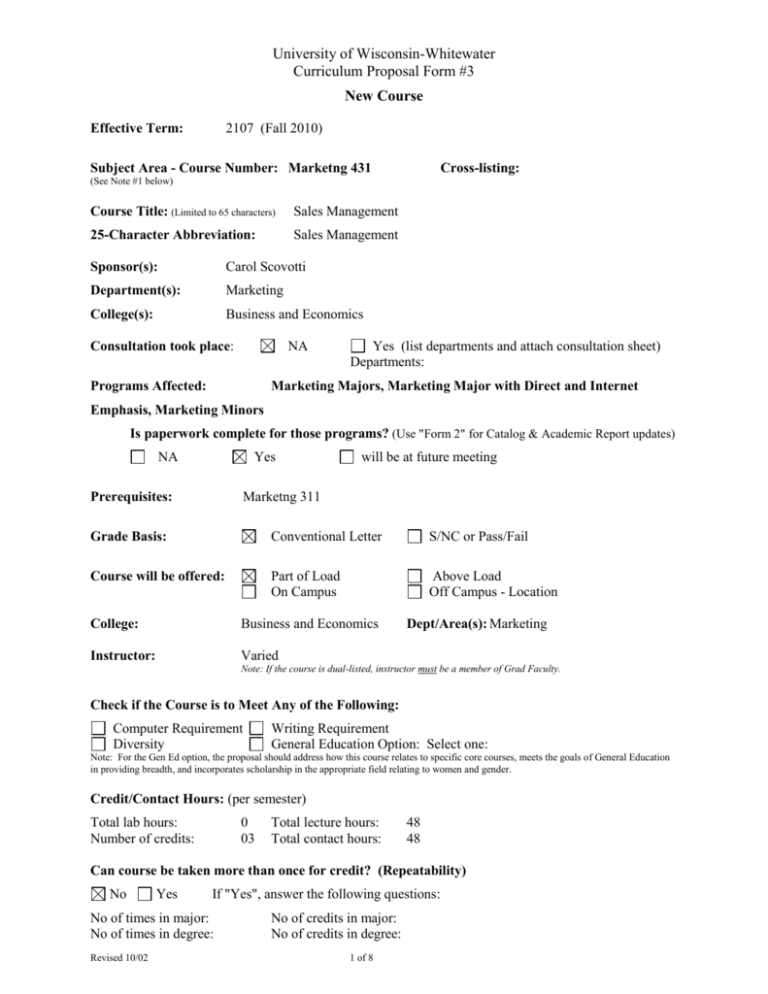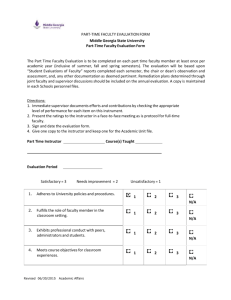_UNDERGRADUATE CURRICULUM - University of Wisconsin
advertisement

University of Wisconsin-Whitewater Curriculum Proposal Form #3 New Course Effective Term: 2107 (Fall 2010) Subject Area - Course Number: Marketng 431 Cross-listing: (See Note #1 below) Course Title: (Limited to 65 characters) Sales Management 25-Character Abbreviation: Sales Management Sponsor(s): Carol Scovotti Department(s): Marketing College(s): Business and Economics Consultation took place: NA Programs Affected: Yes (list departments and attach consultation sheet) Departments: Marketing Majors, Marketing Major with Direct and Internet Emphasis, Marketing Minors Is paperwork complete for those programs? (Use "Form 2" for Catalog & Academic Report updates) NA Yes Prerequisites: will be at future meeting Marketng 311 Grade Basis: Conventional Letter S/NC or Pass/Fail Course will be offered: Part of Load On Campus Above Load Off Campus - Location College: Business and Economics Instructor: Varied Dept/Area(s): Marketing Note: If the course is dual-listed, instructor must be a member of Grad Faculty. Check if the Course is to Meet Any of the Following: Computer Requirement Diversity Writing Requirement General Education Option: Select one: Note: For the Gen Ed option, the proposal should address how this course relates to specific core courses, meets the goals of General Education in providing breadth, and incorporates scholarship in the appropriate field relating to women and gender. Credit/Contact Hours: (per semester) Total lab hours: Number of credits: 0 03 Total lecture hours: Total contact hours: 48 48 Can course be taken more than once for credit? (Repeatability) No Yes If "Yes", answer the following questions: No of times in major: No of times in degree: Revised 10/02 No of credits in major: No of credits in degree: 1 of 8 Course justification: In spring 2008 the Department of Marketing held a retreat to identify our strengths and weaknesses, as well as determine future directions. Led by a professional moderator, this retreat highlighted the fact that the majority of our students take sales positions upon graduation. It also uncovered that our students are not fully prepared for a career in sales, something that has been mentioned frequently by the Department’s Advisory Board. The Advisory Board has also made it clear to the Department that although they like our students very much, they often go elsewhere to look for new sales recruits. Moreover, companies participating in the Career Corner at the American Marketing Association Regional Conferences held at UWW the past two years indicate a great need to develop coursework and learning experiences that create salesready graduates. In fall 2009, a course in Advanced and Entrepreneurial Sales Techniques was introduced. However, this addresses only part of the curricular need. The Department of Marketing Advisory Board gave unanimous approval for a course in Sales Management. Also of relevance, the Entrepreneurship Advisory Board lead by Dr. Peltier indicated that one of the greatest skill gaps that students (and entrepreneurs) have is the lack of sales and selling knowledge. The course has been reviewed by key members of the Department of Marketing Advisory Board and several Career Corner participants. Combined, the Department of Marketing feels that it is imperative to offer a selling course in the marketing curriculum that prepares students to eventually fill positions as sales leaders in businesses. This course also allows them to appreciate and understand the issues surrounding sales force management and retention of sales professionals. Relationship to program assessment objectives: The creation of the course is in response to a departmental objective to create a sales emphasis within the department of marketing and ultimately a sales center. It is in response to a combination of employer feedback, review of best practices in sales curriculum, and a desire within the department of marketing to reach out and develop relationships with key businesses around Whitewater and beyond. Budgetary impact: The course will be offered as part of the normal rotation of classes. Moreover, Dr. Dennis Kopf, new hire for fall 2009, was selected because of his sales background. A new hire scheduled to start in fall 2010 also has experience teaching sales and sales management, and we have an existing instructor teaching Marketing 429 (Personal Selling) with sales management experience. Thus, we have (or are putting) the resources in place and no additional hiring will be necessary to regularly offer this course. Course description: (50 word limit) This course examines sales management from a motivational and an institutional perspective. The goal of the course is to examine the elements of operating an effective sales force as the key Revised 10/02 2 of 8 component to organizational success. Topics include sales force structure, use of technology and issues in compensating and retaining salespeople. Course objectives and tentative course syllabus: Course Objectives One of the biggest challenges to growing a successful business venture is selling. Ongoing institutions and entrepreneurs must build a strong sales pipeline to ensure profitable growth. Students will be exposed to the responsibilities of sales management and the strategic role of sales within the organization. Students will come to understand the elements of an effective sales force as a key component of an organization’s overall marketing effort. The course is designed to teach students how to formulate, implement, and evaluate a sales program. The manager and the entrepreneur must not only understand the sales process but also embrace the fact that the ability to sell is the single most critical success factor of any enterprise, whether new or ongoing. The course covers such complex areas such as how to build and manage a sales force and covers subjects such as building compensation systems for a sales force, assigning territories, resolving disputes and dealing with channel conflicts. The course will extend a student’s understanding the impact of marketing in achieving organizational goals. Course objectives include understanding the sales process, the relationship between sales and marketing, customer relationship management (CRM), sales force structure, use of technology to improve sales force effectiveness and efficiency, and issues in recruiting, training, motivating, compensating and retaining salespeople. The course uses a case-based approach to facilitate interactive discussion including debates and multiple opportunities to apply the theories that are discussed. The class includes a group project where students are responsible for solving a typical, but complex sales management situation. Groups of students are expected to write a paper on the situation and to defend their decisions in front of a panel of sales faculty. This activity forms a capstone for the students in the sales curriculum. Class Evaluation Although the grading components may vary by instructor, below is a general representation of how the course will be conducted. Class Participation (10%): As an interactive course, students are expected to participate in class discussion. Homework or Individual Paper Assignment (20%): Instructor may assign short written assignments throughout the semester or a larger written assignment to be turned in about three weeks before the end of the semester. Tests/Exam (30%): 2 or more tests assigned to evaluate student’s understanding of the required reading material. Revised 10/02 3 of 8 Project Emphasis (40%): Students will be given a case study to work on in groups. Their goal will be to write a paper proposing best management practices that will solve the particular problems experienced in the case. Students will give a presentation of the proposed changes to a panel of judges who will grade them and rank the teams based on their writeen project and presentation. Example Sample of Topics Depending on the selected textbook (i.e., from the newest editions for rental purposes), students will be exposed to topical areas consistent with those listed below. Strategic Planning Introduction to Sales Management The Sales Function and Multi-Sales Channels Sales Leadership Leadership and the Sales Executive Ethics, the Law, and Sales Leadership Analyzing Customers and Markets Business-to-Business (B2B) Sales and Customer Relationship Management Leveraging Information Technologies Designing and Developing the Sales Force Designing and Organizing the Sales Force Recruiting and Selecting the Right Salespeople Training and Developing the Sales Force Process Management Supervising, Managing, and Leading Salespeople Individually and in Teams Setting Goals and Managing the Sales Force’s Performance Motivating and Rewarding Salespeople Measurement, Analysis, and Knowledge Management Turning Customer Information into Knowledge Assessing the Performance of the Sales Force and the People Who Comprise It Internal and External Cultural Forces That Affect a Firm’s Sales Performance Managing an International Sales Force Revised 10/02 4 of 8 Bibliography: Textbooks Sales Management, Jeff Tanner, Earl D. Honeycutt, and Robert C. Erffmeyer, 1st Edition, Prentice Hall, 2008 Harvard Business Review on Strategic Sales Management, Harvard Business Press, 2007. Proactive Sales Management: How to Lead, Motivate and Stay Ahead of the Game, William Miller, 2nd Edition, AMACON. 2009. The Sales Manager’s Success Manual, Wayne Thomas, AMACOM, 2007. Perfect Selling, 1st Edition, Linda Richardson, McGraw Hill. 2008 Why Customers Don't Do What They're Supposed To and What Sales People Can Do About It, 2nd Edition Ferdinand F. Fournies, McGraw Hill. 2007 The Silent Salesmen: Guaranteed Strategies for Increasing Sales and Profits Using Promotional Products, Mitch Carson, Wiley, 2008. Sales 2.0: Improve Business Results Using Innovative Sales Practices and Technology, Anneke Seley, Brent Holloway, Wiley, 2008 Stop Acting Like a Seller and Start Thinking Like a Buyer: Improve Sales Effectiveness by Helping Customers Buy, Jerry Acuff with Wally Wood, Wiley, 2006 Whale Hunting: How to Land Big Sales and Transform Your Company by Tom Searcy, Barbara Weaver Smith, Wiley, 2008. Rethinking Marketing: The Entrepreneurial Imperative, Minet Schindehutte, Prentice Hall, 2008 Revised 10/02 5 of 8 Marketng 431: Sales Management Professor: Dr. Dennis Kopf Office: 3422 Hyland Hall Phone: (262) 472-6948 E-mail: kopfd@uww.edu Office Hours: 3:00 – 5:00 M,W 11:00-3:00 Tue Learning Materials 1) Sales Management, Ingram, LaForge, Avila, Schwepker, and Williams, South-Western/Thompson Learning 2) Other Assigned Readings Objectives Students will be exposed to the responsibilities of sales managers and the strategic role of sales within the organization. The course is designed to teach students how to formulate, implement, and evaluate a sales program. The focus of the course is on the management of a sales program and salespeople. Learning Outcomes and Assessment By the end of the course, students should be able to: Explain the strategic role of personal selling in different business strategies. Develop sales forecasts using objective and subjective methods. Design sales territories. Explain the processes by which to hire, train, motivate and evaluate salespeople. Course Outline 1. 2. 3. 4. 5. 6. 7. 8. 9. 10. 11. 12. 13. Overview of Sales Management What Is Sales Management? Types, Titles, and Hierarchical Levels of Sales Managers. Responsibilities and Duties of Sales Managers. Expanding Roles of Sales Managers. Overview of Personal Selling Summary of Sales Process – The Art and Science of Selling Personal Selling Approaches Contrast Relationship Selling with Traditional Selling Strategic Role of Sales How does sales fit into the marketing and operational arm of an organization? How can sales help with new product development and long range planning? Industrial Buying How do B2B Salespeople understand the needs of industrial buyers? Organization and Structure Purpose and Levels of Organization Planning. Sales Management Planning Process. Causes of Unsuccessful Planning. Organizing the Sales Force. Sales Territories Improving Sales Productivity. Establishing Sales Territories. Setting Up Sales Territories. Revising Sales Territories. Self-Management. Time Management and Routing. Sales Forecasting Sales Forecasting and Its Relationship to Operational Planning. Forecasting Approaches and Techniques. Evaluating Forecasting Approaches. Sales Budget Planning. Preparing the Annual Sales Budget. Recruiting and Hiring Importance of Recruiting and Selection. The Recruitment Process. Sources of Salespeople. The Sales Force Selection Process. Making the Selection. Sales Force Socialization. Sales Training Importance of Sales Training. Developing and Implementing Sales Training. Making Training Delivery Decisions. Choosing Instructional Methods. Preparing, Motivating, and Coaching Trainees. Evaluating Training Programs. Sales Training Challenges for Global Companies. Leadership Foundations of Leadership. Supervision, Management, and Leadership. Leadership and Power. Applying Classical Leadership Theories to Twenty-First-Century Sales Management. Applying Contemporary Leadership Theories to Twenty-First-Century Sales. Management. Other Emerging Issues in Twenty-First-Century Sales Force Leadership. Communication. Motivation and Reward Foundations of Motivation. Applying Contemporary Motivation Theories to Sales Management. Using Rewards and Incentive Programs for Sales Force Motivation. Additional Perspectives in Twenty-First-Century Sales Force Motivation. Evaluating the Organization Sales Force Performance Appraisal. Providing Feedback and Improving Sales Force Performance. Emerging Perspectives in Twenty-First-Century Sales Force Performance Appraisals. Revised 10/02 6 of 8 14. Cost Analysis Framework for Sales Force Organizational Audit. Sales Volume, Costs, and Profitability Analysis. Increasing Sales Force Productivity and Profits. 15. Salesperson Performance Evaluation Sales Force Performance Appraisal. A Contemporary Approach to Sales Force Performance Evaluation. Providing Feedback and Improving Sales Force Performance. Emerging Perspectives in Twenty-First-Century Sales Force Performance Appraisals. Grading: Homework Examination 1 Examination 2 Examination 3 Final Project Points 100 100 100 100 Date Varies 9/30 10/29 12/13 200 12/03 Attendance Policy: Regular attendance is required at all class meetings. See class participation section of syllabus for more details. Project The class project, an integral part of the course, gives students the chance to apply the main themes we discuss. Each team will be charged with developing an appropriate plan to manage the selling effort for a specific B2B situation. Structure, strategy, compensation, training, and other elements are included. The cornerstone of the project is a detailed written plan covering specific assignments. In addition, teams will have the opportunity to present their plan to the class and defend it. The project will be worth 200 points. Exams Exams will cover material from the books, lectures, and other material discussed or assigned in class or posted on my web page. The exam format is typically multiple-choice, sometimes with some short answer questions. Exams are closed book, closed notes, closed friend, and calculator-free. Cell phones must be turned off and put away, and hats must be removed unless you receive permission to wear one 24 hours prior to the exam. Books, bags, and calculators must be put in the front of the classroom prior to the exam. Any student found in possession of a cell phone, calculator or other electronic device during the exam will receive a grade of zero for the exam. I reserve the right to move anyone before or during an exam. Make up policy: Quizzes and exams can be made up only after provision of a valid excuse of absence such as Dr. Office, Work/Employer, and University Function and in some cases family emergencies. The missed quiz or exam must be taken within one week of the original quiz or exam date. Participation Participation in class enriches the learning experience for everyone. You are encouraged to ask questions and make comments to enhance the class, within the limits that class size and time allow. Active participation may help your grade. Beyond participation in class, students may submit articles and other material that relates to the course. Be sure to put your name on all submissions. Unless requested in writing, submissions will not be returned. Grades: A 90% or above Revised 10/02 7 of 8 B C D F 80-89.9% 70-79.9% 60-69.9% Below 60% The University of Wisconsin-Whitewater is dedicated to a safe, supportive and nondiscriminatory learning environment. It is the responsibility of all undergraduate and graduate students to familiarize themselves with University policies regarding Special Accommodations, Academic Misconduct, Religious Beliefs Accommodation, Discrimination and Absence for University Sponsored Events. For details, please refer to the Undergraduate and Graduate timetables; the “Rights and Responsibilities” section of the Undergraduate Bulletin; the Academic Requirements and Policies and the Facilities and Services sections of the Graduate Bulletin; the “Student Academic Disciplinary Procedures (UWS Chapter 14); and the “Student Nonacademic Disciplinary Procedures (UWS Chapter 17). Feel free to talk to me should you require any special accommodations. Student Honor Code: “UW-Whitewater’s College of Business and Economics students are expected to subscribe to the College’s Student Honor Code: As members of the University of Wisconsin-Whitewater College of Business and Economics community, we commit ourselves to act honestly, responsibly, and above all, with honor and integrity in all areas of campus life. We are accountable for all that we say and write. We are responsible for the academic integrity of our work. We pledge that we will not misrepresent our work or give or receive unauthorized aid. We commit ourselves to behave in a manner that demonstrates concern for all personal dignity, rights and freedoms of all members of the community. We are respectful of college property and the property of others. We will not tolerate a lack of respect for these values.” Revised 10/02 8 of 8








